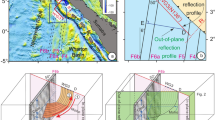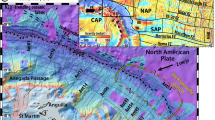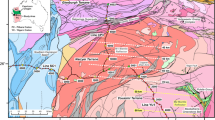Abstract
At convergent continental margins, the relative motion between the subducting oceanic plate and the overriding continent is usually accommodated by movement along a single, thin interface known as a megathrust1. Great thrust earthquakes occur on the shallow part of this interface where the two plates are locked together2. Earthquakes of lower magnitude occur within the underlying oceanic plate, and have been linked to geochemical dehydration reactions caused by the plate's descent3,4,5,6,7. Here I present deep seismic reflection data from the northern Cascadia subduction zone that show that the inter-plate boundary is up to 16 km thick and comprises two megathrust shear zones that bound a >5-km-thick, ∼110-km-wide region of imbricated crustal rocks. Earthquakes within the subducting plate occur predominantly in two geographic bands where the dip of the plate is inferred to increase as it is forced around the edges of the imbricated inter-plate boundary zone. This implies that seismicity in the subducting slab is controlled primarily by deformation in the upper part of the plate. Slip on the shallower megathrust shear zone, which may occur by aseismic slow slip, will transport crustal rocks into the upper mantle above the subducting oceanic plate and may, in part, provide an explanation for the unusually low seismic wave speeds that are observed there8,9.
This is a preview of subscription content, access via your institution
Access options
Subscribe to this journal
Receive 51 print issues and online access
$199.00 per year
only $3.90 per issue
Buy this article
- Purchase on Springer Link
- Instant access to full article PDF
Prices may be subject to local taxes which are calculated during checkout




Similar content being viewed by others
References
Rogers, G. C. An assessment of the megathrust earthquake potential of the Cascadia subduction zone. Can. J. Earth Sci. 26, 844–852 (1988)
Hyndman, R. D. & Wang, K. The rupture zone of Cascadia great earthquakes from current deformation and the thermal regime. J. Geophys. Res. 100, 22133–22154 (1995)
Kirby, S. H. et al. in Subduction: Top to Bottom (ed. Bebout, G. E.) 195–214 (American Geophysical Union, Washington DC, 1996)
Peacock, S. M. & Wang, K. Seismic consequences of warm versus cool subduction metamorphism: Examples from southwest and northeast Japan. Science 286, 937–939 (1999)
Peacock, S. M. Are the lower planes of double seismic zones caused by serpentine dehydration in subducting oceanic mantle? Geology 29, 299–302 (2001)
Hacker, B. R., Peacock, S. M., Abers, G. A. & Holloway, S. D. Subduction factory 2. Are intermediate-depth earthquakes linked to metamorphic dehydration reactions? J. Geophys. Res. 108, doi:10.1029/2001JB001129 (2003)
Preston, L. A., Creager, K. C., Crosson, R. S., Brocher, T. M. & Tréhu, A. M. Intraslab earthquakes: Dehydration of the Cascadia slab. Science 302, 1197–1200 (2003)
Stanley, D., Villasenor, A. & Benz, H. Subduction Zone and Crustal Dynamics of Western Washington: A Tectonic Model for Earthquake Hazards Evaluation Open File Report 99–311 (US Geological Survey, Reston, 1999)
Ramachandran, K. Velocity Structure of S.W. British Columbia and N.W. Washington from 3-D Non-linear Seismic Tomography Thesis, Univ. Victoria (2001)
Spence, G. D., Clowes, R. M. & Ellis, R. M. Seismic structure across the active subduction zone of western Canada. J. Geophys. Res. 90, 6754–6772 (1985)
Clowes, R. M., Yorath, C. J. & Hyndman, R. D. Reflection mapping across the convergent margin of western Canada. Geophys. J. R. Astron. Soc. 89, 79–84 (1987)
Green, A. G. et al. Seismic reflection imaging of the subducting Juan de Fuca plate. Nature 319, 210–213 (1986)
Clowes, R. M. et al. LITHOPROBE—southern Vancouver Island: Cenozoic subduction complex imaged by deep seismic reflections. Can. J. Earth Sci. 24, 31–51 (1987)
Calvert, A. J. & Clowes, R. M. Deep, high-amplitude reflections from a major shear zone above the subducting Juan de Fuca plate. Geology 18, 1091–1094 (1990)
Calvert, A. J. Seismic reflection constraints on imbrication and underplating of the northern Cascadia convergent margin. Can. J. Earth Sci. 33, 1294–1307 (1996)
Nedimović, M. R., Hyndman, R. D., Ramachandran, K. & Spence, G. D. Reflection signature of seismic and aseismic slip on the northern Cascadia subduction interface. Nature 424, 416–420 (2003)
Hasselgren, E. O. & Clowes, R. M. Crustal structure of northern Juan de Fuca plate from multichannel seismic reflection data. J. Geophys. Res. 100, 6469–6486 (1994)
Fisher, M. A. et al. Seismic survey probes urban earthquake hazards in Pacific Northwest. Eos 80, 16–17 (1999)
Brocher, T. M. et al. Wide-angle Seismic Recordings from the 1998 Seismic Hazards Investigation in Puget Sound (SHIPS), Western Washington and British Columbia Open File Report 99–314 (US Geological Survey, Reston, 1999)
Dehler, S. A. & Clowes, R. M. Integrated geophysical modelling of terranes and other structures along the western Canadian margin. Can. J. Earth Sci. 29, 1492–1508 (1992)
Cassidy, J. F. & Ellis, R. M. Shear wave constraints on a deep crustal reflective zone beneath Vancouver Island. J. Geophys. Res. 96, 19843–19851 (1991)
Yorath, C. J. et al. Marine Multichannel Seismic Reflection, Gravity and Magnetic Profiles—Vancouver Island Continental Margin and Juan De Fuca Ridge (Open File Report 1661, Geological Survey of Canada, Vancouver, 1987)
Hyndman, R. D. Dipping reflectors, electrically conductive zones and free water beneath a subduction zone. J. Geophys. Res. 93, 13391–13405 (1988)
Dragert, H., Wang, K. & James, T. S. A silent slip event on the deeper Cascadia subduction interface. Science 292, 1525–1528 (2001)
Rogers, G. & Dragert, H. Episodic tremor and slip on the Cascadia subduction zone: The chatter of silent slip. Science 300, 1942–1943 (2003)
Kao, H., Shan, S.-J., Rogers, G., Cassidy, J. F. & Dragert, H. Temporal and spatial distribution of the tremors in the episodic tremor and slip (ETS) event observed beneath the northern Cascadia subduction zone in early 2003. Eos 84 (Fall Meeting Suppl.), S42G–02 (2003)
Bolton, M. K. & Rogers, G. C. Juan de Fuca plate seismicity at the northern end of the Cascadia subduction zone. Seismol. Res. Lett. 73, 214 (2002)
Ranero, C. R. & von Huene, R. Subduction erosion along the Middle America convergent margin. Nature 404, 748–752 (2003)
Wells, R. E., Blakely, R. J., Sugiyama, Y., Scholl, D. W. & Dinterman, D. A. Basin-centered asperities in great subduction zone earthquakes: A link between slip, subduction and subduction erosion. J. Geophys. Res. 108, doi:10.1029/2002JB002072 (2003)
Brocher, T. M., Fuis, G. S., Fisher, M. A., Plafker, G. & Moses, M. J. Mapping the megathrust beneath the northern Gulf of Alaska using wide-angle seismic data. J. Geophys. Res. 99, 11663–11685 (1994)
Acknowledgements
I thank K. Ramachandran for making available to me the 3D velocity model and the positions of the relocated earthquakes; T. Brocher for comments and suggestions that helped to improve the final manuscript; and H. Kao and M. Nedimović for discussions. This project was funded by the Natural Sciences and Engineering Research Council of Canada.
Author information
Authors and Affiliations
Corresponding author
Ethics declarations
Competing interests
The author declares that he has no competing financial interests.
Rights and permissions
About this article
Cite this article
Calvert, A. Seismic reflection imaging of two megathrust shear zones in the northern Cascadia subduction zone. Nature 428, 163–167 (2004). https://doi.org/10.1038/nature02372
Received:
Accepted:
Issue Date:
DOI: https://doi.org/10.1038/nature02372
This article is cited by
-
Physical conditions and frictional properties in the source region of a slow-slip event
Nature Geoscience (2021)
-
Cascadia low frequency earthquakes at the base of an overpressured subduction shear zone
Nature Communications (2020)
-
Rapid interferometric imaging of printed drug laden multilayer structures
Scientific Reports (2014)
-
A wide depth distribution of seismic tremors along the northern Cascadia margin
Nature (2005)
Comments
By submitting a comment you agree to abide by our Terms and Community Guidelines. If you find something abusive or that does not comply with our terms or guidelines please flag it as inappropriate.



